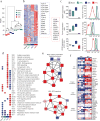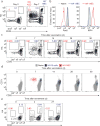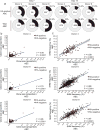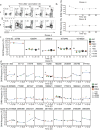Defining antigen-specific plasmablast and memory B cell subsets in human blood after viral infection or vaccination
- PMID: 27525369
- PMCID: PMC5054979
- DOI: 10.1038/ni.3533
Defining antigen-specific plasmablast and memory B cell subsets in human blood after viral infection or vaccination
Abstract
Antigen-specific B cells bifurcate into antibody-secreting cells (ASCs) and memory B cells (MBCs) after infection or vaccination. ASCs (plasmablasts) have been extensively studied in humans, but less is known about B cells that become activated but do not differentiate into plasmablasts. Here we have defined the phenotype and transcriptional program of a subset of antigen-specific B cells, which we have called 'activated B cells' (ABCs), that were distinct from ASCs and were committed to the MBC lineage. We detected ABCs in humans after infection with Ebola virus or influenza virus and also after vaccination. By simultaneously analyzing antigen-specific ASCs and ABCs in human blood after vaccination against influenza virus, we investigated the clonal overlap and extent of somatic hypermutation (SHM) in the ASC (effector) and ABC (memory) lineages. Longitudinal tracking of vaccination-induced hemagglutinin (HA)-specific clones revealed no overall increase in SHM over time, which suggested that repeated annual immunization might have limitations in enhancing the quality of influenza-virus-specific antibody.
Conflict of interest statement
The authors declare no competing financial interests.
Figures







References
Publication types
MeSH terms
Substances
Grants and funding
LinkOut - more resources
Full Text Sources
Other Literature Sources
Medical
Molecular Biology Databases
Miscellaneous

